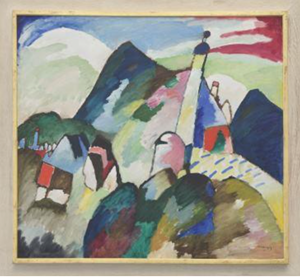
The Committee has assessed an application dated 25 February 2019 for restitution of the painting Blick auf Murnau mit Kirche [known in English as View of Murnau with Church] by the artist Wassily Kandinsky
The Committee has assessed an application dated 25 February 2019 for restitution of the painting Blick auf Murnau mit Kirche [known in English as View of Murnau with Church] by the artist Wassily Kandinsky. Eindhoven City Council became owner of the work in 1951, and it has hung in the Van Abbemuseum in Eindhoven since then. The Committee issued a binding opinion on 29 January 2018 rejecting an earlier application for restitution of this work because it was not possible to establish with the required degree of plausibility that Johanna Margarethe Stern-Lippmann (1874-1944), the Applicants’ Jewish grandmother/great-grandmother, had lost possession of the work during the Nazi regime.
The request for reconsideration by the City Council and the Applicants was submitted on the grounds of new facts that apparently had emerged from correspondence and lists of artworks that were not previously known to the Committee. The Committee has established that these documents do indeed contain new facts.
Those new facts and the investigation that was launched on the basis of them have given the Committee reason to conclude that it is now sufficiently plausible that the painting ceased to be in the possession of Margarethe Stern-Lippmann during the Nazi regime.
The Committee’s changed conclusion is based on the following three considerations. In accordance with the requirement in the Washington Principles, during the assessment the Committee took into account ‘unavoidable gaps or ambiguities in the provenance in light of the passage of time and the circumstances of the Holocaust era’.
Viewing 1, 2 and 3 together, the Committee concludes that it is plausible that the work did not leave the possession of Margarethe Stern-Lippmann before the occupation, that the family did not sell it after the occupation, that Margarethe lost possession of it during the occupation, and that it came into the possession of the Franks. Margarethe’s loss of possession took place during the occupation and she was a private individual who, because of her Jewish descent, belonged to a persecuted population group. On the grounds of criterion 3.1 of the assessment framework, the Committee therefore assumes that her loss of possession was involuntary. The Committee therefore rules that the Kandinsky painting should be returned to the heirs of the original owner.

ArtDependence Magazine is an international magazine covering all spheres of contemporary art, as well as modern and classical art.
ArtDependence features the latest art news, highlighting interviews with today’s most influential artists, galleries, curators, collectors, fair directors and individuals at the axis of the arts.
The magazine also covers series of articles and reviews on critical art events, new publications and other foremost happenings in the art world.
If you would like to submit events or editorial content to ArtDependence Magazine, please feel free to reach the magazine via the contact page.